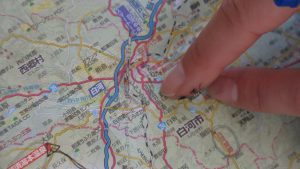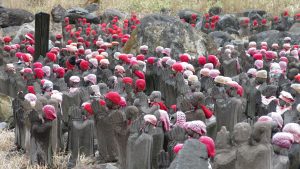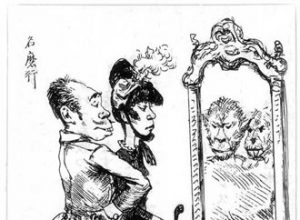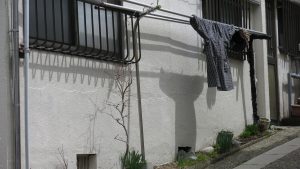
Sophie Houdart and Mélanie Pavy travel to see what remains of the 2011 Fukushima nuclear disaster. They are looking, in order to talk about it, for the right shape. They fill notebooks upon notebooks. They observe with the greatest possible care. To talk about the world today, they start with the infinitely small. They are, in their way, like Cornelia Hesse-Honegger, a scientific illustrator at the Zurich Zoological Institute, who paints tiny irradiated animals under a microscope.
Laurence Bertrand Dorléac
The radiant thing
Sophie Houdart and Mélanie Pavy
She reads
She reads that in one of the opening chapters of his Insectopedia, Hugh Raffles, anthropologist and specialist of the Amazon, described meeting German artist Cornelia Hesse-Honegger. It is said that Cornelia Hesse-Honegger, scientific illustrator at the Zoological Institute of Zurich, is known, in artistic circles, for her ‘Quasimodo’ paintings: mutated insects in turn ‘maimed’, ‘pitiful’, ‘monstrous’, and ‘chaotic’.1H. Raffles, Insectopédie, Paris, Wildproject, 2016, p. 25. Incidentally, those insects make up a collection of small irradiated beings: irradiated in a laboratory environment (as part of experimental studies by geneticists of the Institute) first of all, then in vivo. It is explained that, since the Chernobyl disaster in 1986, Cornelia Hesse-Honegger collects the everyday abnormalities occurring on the outskirts of various nuclear plants, regardless of whether they were devastated or not: Chernobyl in Ukraine, Österfärnbo in Sweden, Sellafield in England, Gundremmingen in Germany, La Hague in France… It is understood that what she collects are the spectacular effects that turn irradiated things into ‘marvels’ – once magnified under a microscope –; but that these are also evidence, used to try to persuade scientists of the following: contrarily to the then oft-repeated claim that strong doses of radiation resulted in strong effects and small doses in small effects, it is further understood that what she observed, under her microscope and by painting, showed a vulnerability that affected individuals in their very beings. She then said she was ‘possessed’, ‘submerged by a vision, by the visceral belief that she saw something invisible to others, the disturbing pathologies of these invisible insects’,2Ibid., p. 36. and this visceral belief had her losing sleep. ‘If one wants to systematically explore the relationship between two things’, she says, ‘one cannot expect to find a pure, unambiguous, causal relation. The idea that the truth will emerge evidently by itself should be set aside. Things need space to express themselves. Each individual singularity (or each combination of singularities) found inside a given population can potentially have meaning’.3Ibid., p. 48.
She interrupts her reading here. Finding space to let radiant things express themselves, that is also what their question is since they went to the north-east of Japan after the triple catastrophe of 2011. They wonder: what would, still, be the way to grasp a thing that is invisible, odorless, untouchable – other than by its effects? A thing capable of piercing space and bending time, of making it fall apart? How do we shape it?
They are looking for a shape. A shape to talk about the thing, to contain it, to fumble around it – like a blindman with a walking stick, as Maylis de Kerangal once said. Fumbling, she had added, ‘to capture an awareness of surfaces’, exploring through a series of connected touches (placing a hand there, then right beside it, etc.) the consistency of a thing, by parsing its shape, mapping it, giving it body. They are looking for a shape to make sensible the properties of what is happening to them: a thing that happened to them rather than one they sought, a thing that catches then releases them, holds and then lets them go, ever fluctuating. They are looking for a shape, a shape they can test out, but also a shape that can translate how unsure they are of what they saw. Are they sure of what they saw and how? Are they sure of what was said? And how?
They decide to go over what they saw, wrote down, photographed, and documented as much as they could during the trips they took together around Tôwa, a small town located fifty kilometers away from Fukushima Daiichi nuclear power station, and whose inhabitants had not been moved after the march 2011 disaster. Instead, after, they had learned to live anew in their habitat, to make do with these invisible turmoils, to live with what had happened. They decided to go over it, once more, see it again, read it again, unpack it, sort through what had been put aside, the “leftovers”. They asked themselves: what is the nature of what has left? They took turns, reading to each other their notebooks, they described their images, added books, movies, works that cast a light on, added to, complicated, sometimes tenuously and sinuously, the fragile experiences they went through together, in an uncertain landscape.4The authors would like to thank the residency fellowships of Art Explora – Cité Internationale des Arts, which allowed them to work on the present project.
She says: I open the file dated from the 14th of April 2016. She describes the pictures, tired eyes, hands on a map, a pen pointing to a precise location. In looking at the pictures, she recalls the morning, arriving in the town of Nasu, visited by the poet Matsuo Bashô himself. When she saw a kimono laid out to dry, the shadow of a kimono laid out to dry, she remembers thinking about the shadow cast by the bodies at Hiroshima.
She cannot remember what they were looking for together on the map. She sees a doe’s head, made of stone, a close-up of the bark of a tree, a long stairway, climbing steeply into the forest, flanked by two steles and a stone lantern. She remembers the temple. The dizzying climb to the temple. Shoes and steps, shoes and steps, shoes, stop. She still remembers the strange valley onto which the path opened to. She remembers the feel of it, monochromatic, gray. And yet she can see other colors in the photograph. A small patch of green lawn. A brownish border around where the stones should be. A multitude of small red dots and black lines. She remembers not understand straight away what they were.
She had had to zoom in to discover small statues of Jizô, god of protection, all wearing small bright red caps.
Playing the recordings, she hears swathes of birds. Voices. It is said that that this place is very weird, how crazy it is that seeing it lived in makes it real! Through the sounds, she feels like the space is getting bigger, more organized, more complex. It is said that, many years ago, there was a mean fox with a white face, a golden pelt and nine tails. He transformed into a stunning woman and went from China to India, committing crime after crime. Eight thousand years ago, the fox came to Japan, where he once again became a beautiful woman. Her name was Lady Tamamo. A courtesan at the imperial court, she sought to destroy the country. Her true identity was unmasked by a seer, and she ran away, as a fox, to the plains of Nasu, where she started her crimes once more. The emperor then sentenced her to death. He raised an army of eighty thousand men and the fox was killed. But she transformed into a poisonous stone that killed anything that touched it. The stone is said to have been destroyed by a Buddhist monk, who chanted sutras for days on end. A white cloud rose, and the stone broke into three pieces, once of which remained here.
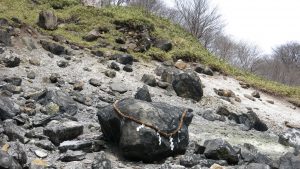
Fig. 4. The « killing stone », Nasu (Mélanie Pavy DR).
She had forgotten the story, both myth and history. She remembers the sulfuric atmosphere of the place, the way it stayed with you with persistent odiousness, which Bashô had also noticed. She also remembers the roadmap they had found in the grass just as they needed to buy one. She hears: this is the difficult-to-return zone. She hears: we won’t be able to go through there.
One sound, image-less. An interior. She remembers the small lounge with gray chairs, the talk they had. At length. They said: when you take in the map in one go, you realize you are there. They said that there is, in their experiences, variations in intensity. They said that documenting these experiences could deplete their intensity.
They said they could uphold the question: when does it feel like you have arrived at the place we call Fukushima in France? Is the physical distance between the accident and ourselves really relevant? They ask themselves if they would be able to pinpoint the moment they make contact with radioactivity, if they will feel endangered, if they will feel changed, if they can put their trust in visual evidence. If information, measurements, are trustworthy markers. They ask themselves how to sharpen these skills by trying to become sensitive to the invisible changes disseminated in the air, under the earth, and inside all kinds of living things. They have already understood that it would not be easy, that their methodology would be shaken, their certainties would crumble because radioactive elements disrupt landscapes, things, bodies, feelings, fears…
She puts on L’épopée du radium, a short movie made by the IRSN.5Institut de Radioprotection et de Sûreté Nucléaire. This short movie was made to go alongside the exhibition: ‘Vous avez dit radioprotection ? Histoires de rayons X, de radioactivité…’, which took place at the Pavillon des Sciences at Montbéliard, from the 15th of October 2007 to the 27th of April 2008. https://www.irsn.fr/FR/connaissances/Nucleaire_et_societe/education-radioprotection/histoire/Pages/2-radioactivite-naturelle-radium.aspx#.YHBImD8682w It explains that Marie Curie and her husband Pierre lived for one unique problem, would be in raptures over vials that spontaneously emitted rays and whose heat source seemed endless. Where does radium get its energy? Does it come from its habitat? Is it within it? It is said that the two scientists went as far as, in order to answer these questions, seeking out other scientists that organized seances of spiritism. It was discovered that radioactivity was the transformation of one chemical element into another via the emitting of rays. It is described how radium took over the medical world, little jabs of radium making ungainly blotches disappear from faces and bodies. It is said that radium is a miraculous ingredient, that it will become part of many creams, paints, the ends of lightning rods. It is told how, later, evidence of the toxicity of radium mounted. How the first known cancers befell the female American workers in clock factories, as they wetted the tip of their brushes with their tongue. It is decreed in 1970 that radium would be definitely banned to protect from radioactivity. It is not said if that ban holds for the entire world. It is told how the IRSN has since been collecting objects containing radium.

Fig. 5. Le chemin étroit vers les contrées du Nord, Bashô transl. by Nicolas Bouvier (The Narrow road to Oku). (Mélanie Pavy DR).
She stops the movie. She opens the small booklet of the Mineralogy Museum of Ishikawa, in the Fukushima district. It is said that …
1] H. Raffles, Insectopédie, Paris, Wildproject, 2016, p. 25.
2] Ibid., p. 36.
3] Ibid., p. 48.
4] The authors would like to thank the residency fellowships of Art Explora – Cité Internationale des Arts, which allowed them to work on the present project.
5] Institut de Radioprotection et de Sûreté Nucléaire. This short movie was made to go alongside the exhibition: ‘Vous avez dit radioprotection ? Histoires de rayons X, de radioactivité…’, which took place at the Pavillon des Sciences at Montbéliard, from the 15th of October 2007 to the 27th of April 2008. https://www.irsn.fr/FR/connaissances/Nucleaire_et_societe/education-radioprotection/histoire/Pages/2-radioactivite-naturelle-radium.aspx#.YHBImD8682w
6] http://www.f93.fr/fr/project/11/call-it-anything.html
Bibliography
Bashô, M., Le chemin étroit vers les contrées du Nord, transl. by N. Bouvier, Paris, Héros-Limite Eds., 2007.
Didi-Huberman, G., Essayer voir, Paris, Les Editions de Minuit, 2014.
Houdart, S. and Pavy, M., « ‘On sort donc les tripes petit à petit’. Consistance d’un territoire contaminé », Terrain 71, 2019, https://journals.openedition.org/terrain/18195.
Kohso, S., Yoko Hayasuke, H., Yabu, S., Matsumoto, M., and Gensai Mori, M., Fukushima et ses invisibles, Vaulx-en-Velin, Les Editions des mondes à faire, 2018.
Raffles, H., Insectopédie, transl. by M. Dumont, Paris, Wildproject, 2016.
Rouy, P., Fukushima_camera, Cinéma Différent/JHR Films, 2019.
Mélanie Pavy is an artist, filmmaker and researcher. She was a fellow of the Villa Kujoyama in Kyoto in 2012. Her first full-lenght feature, Ashes (co-directed with Idrissa Guiro) was released in France in 2015. In 2020, she defended a PhD in film studies within the SACRe doctoral program (PSL/La Fémis/ENS). Her installations and videos have been shown in personal and collective exhibitions in places such as the BAL, the Galerie Les filles du Calvaire, the Centre Georges Pompidou, the Gaîté Lyrique. Through her work she seeks to interrogate our ability to think and narrate the loss of a world.
Sophie Houdart is an anthropologist, research director at the CNRS, at the Laboratory of Ethnology and Comparative Sociology. She has completed several field studies, mainly in Japan, on the theme of creation and innovation in the fields of the science, art or architecture. Since 2012 she is working on the Fukushima district and on life after the march 2011 disaster.
They are both part of the hybrid collective Call it Anything, which brings together several researchers, artists and filmmakers around crossed experimentations on the themes of trouble, damaged territory, radioactivity, and the restoration of the existing (F93).6http://www.f93.fr/fr/project/11/call-it-anything.html
